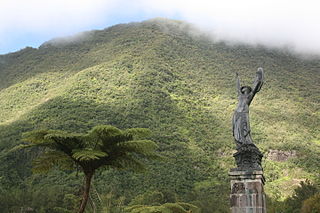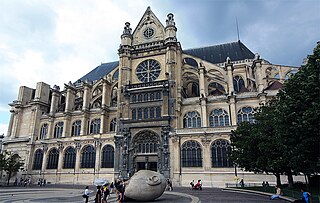 W
WAir is a lead or bronze sculpture, by Aristide Maillol.
 W
WL'Âme de la France is the name given by the French sculptor Carlo Sarrabezolles to three identical monumental statues that he executed in three different materials during the interwar period, the first in plaster in 1921, the second in stone in 1922, and the last in bronze in 1930. 3.2 metres tall, they represent a female warrior with naked breasts raising her arms toward the sky.
 W
WBalzac in the Robe of a Dominican Monk is a bronze sculpture by French artist Auguste Rodin, one of the studies made in preparation to the Monument to Balzac, a tribute to novelist Honoré de Balzac commissioned by the Society of Men of Letters of France in 1891. This sculpture was a particular challenge to the artist due to his preference to portray his subjects in great detail, and the fact that Balzac was already dead. Rodin then started to research about the life and times of his subject, only to find, according to Kenneth Clark, that he had been a short, fat and unremarkable-looking man.
 W
WThe Burghers of Calais is a sculpture by Auguste Rodin, that exists in twelve original castings, and numerous copies. It commemorates an event during the Hundred Years' War, when Calais, a French port on the English Channel, was under siege by the English for about eleven months. Calais commissioned Rodin to create the sculpture in 1884 and the work was completed in 1889.
 W
WThe War memorial of Céret is a World War I memorial in France, located in Céret (Pyrénées-Orientales). The sculpture for the memorial was made from 1919 to 1920 by Aristide Maillol and the memorial itself was inaugurated in 1922. It was declared a national monument in 1994.
 W
WThe Cimetière des Chiens et Autres Animaux Domestiques is often claimed to be the first zoological necropolis in the modern world. The ancient Ashkelon dog cemetery predates it by thousands of years. It opened in 1899 at 4 pont de Clichy on Île des Ravageurs in Asnières-sur-Seine, Île-de-France.
 W
WLes Deux Plateaux, more commonly known as the Colonnes de Buren, is a highly controversial art installation created by the French artist Daniel Buren in 1985–1986. It is located in the inner courtyard of the Palais Royal in Paris, France.
 W
WÉcoute is a sculpture by French artist Henri de Miller in Paris. It is a giant stone head with cupped hand in front of the Church of St-Eustache. It is near to another sculpture by the same artist; a very large sundial designed by the astronomer Dandrel and made by the sculptor, in the Jardin des Halles, above the Forum des Halles.
 W
WThe equestrian statue of Henry IV is a bronze equestrian statue completed by Pietro Tacca. The statue, which now stands on the bridge Pont Neuf, was indirectly commissioned by Marie de Médicis for her husband, King Henry IV of France. The original commissioned artist, Giambologna, had died before its completion, making Pietro Tacca take over the commission. The statue itself was erected in 1614. It was then torn down in 1792 during the French Revolution, but was later rebuilt by 1818.
 W
WL’Été sans bras is a sculpture made by Aristide Maillol in 1911.
 W
WFrance Crowning Art and Industry is a 6.50 m (21 ft) tall limestone sculpture group which decorated the top of the entrance of Palais de l'Industrie, the main building of the 1855 international exhibition in Paris. It was moved to the park of Saint-Cloud in 1900 when the palais de l'Industrie was demolished. The center group, composed of the three allegories is a work by sculptor Élias Robert. The two putti groups located on its sides are by Georges Diebolt. The wreaths France was carrying in her hands and most of the rays of the radiant crown she wears have now disappeared.
 W
WThe Geoscope is a monumental display of rocks at the La Lozère motorway service at junction 32 of the A75 autoroute at Albaret-Sainte-Marie in the department of Lozère, France. It is sometimes described as a geological museum. 45 stones, each weighing many tonnes and accompanied by an interpretive panel are artistically arranged in a circle in an old quarry.
 W
WJoan of Arc is a monumental bronze sculpture by French sculptor Paul Dubois. It depicts Joan of Arc both as a warrior and as a divinely inspired visionary.
 W
WThe Lion of Belfort, in Belfort, France, is a monumental sculpture by Frédéric Bartholdi, the sculptor of the Statue of Liberty.
 W
WMonument to Balzac is a sculpture by Auguste Rodin in memory of the French novelist Honoré de Balzac. According to Rodin, the sculpture aims to portray the writer's persona rather than a physical likeness. The work was commissioned in 1891 by the Société des Gens de Lettres, a full-size plaster model was displayed in 1898 at a Salon in Champ de Mars. After coming under criticism the model was rejected by the société and Rodin moved it to his home in Meudon. On July 2, 1939 the model was cast in bronze for the first time and placed on the Boulevard du Montparnasse at the intersection with Boulevard Raspail.
 W
WNeuf lignes obliques is a steel monument on the Promenade des Anglais, by French artist Bernar Venet. It was commissioned to mark the 150th anniversary of the 1860 annexation of the County of Nice by France.
 W
WLa Rivière is a lead or bronze sculpture by Aristide Maillol.
 W
WThe Sculpture Park Erich Engelbrecht is located at the Château des Fougis, 03220 Thionne, department of Allier, France, and displays monumental massive steel sculptures of the German artist Erich Engelbrecht.
 W
WSculptures Bachelard is an In Situ work by French artist Jean-Max Albert installed in 1986 in the Parc de la Villette, Paris, France. It is named after the author of The Poetics of Space, Gaston Bachelard. It consists of a set of 8 sculptures arranged around the perimeter of the Jardin de la Treille.
 W
WLa statue de la Résistance par Falguière was a 9-foot tall snow sculpture of a nude woman with a cannon made on 8 December 1870 by Alexandre Falguière during the Siege of Paris in the Franco-Prussian War. Falguière was a member of a National Guard company comprising many artists and intellectuals, among them Felix Philipoteaux. Falguière, assisted by his comrades, erected the statue in a few hours, to symbolize French resistance to Prussia. Philipoteaux's sketch of the sculpture was published later that month. It became a tourist attraction, along with a less celebrated snow bust by Hippolyte Moulin near by. Theodore de Banville wrote an ode and Felix Bracquemond made an etching published by Faustin Betbeder. After he snow sculpture had melted, Falguière's attempts to recreate it in a more permanent medium were unsuccessful, lacking the original's spontaneity. It was Falguière's first female nude, a subject in which he later specialised.
 W
WA statue of Johannes Gutenberg by David d'Angers is installed on Place Gutenberg in Strasbourg, France.
 W
WUNESCO Reclining Figure 1957–58 is a sculpture by Henry Moore. It was made in a series of scales, from a small plaster maquette, through a half-size working model made in plaster and cast in bronze, to a full-size version carved in Roman travertine marble in 1957–1958. The final work was installed in 1958 at the World Heritage Centre, the headquarters of UNESCO at the Place de Fontenoy in Paris. This was Moore's last major public commission in which he created a new work for a specific site; he afterwards generally worked from an existing sketch or model.
 W
WThe Zouave is an 1856 stone statue by French artist Georges Diebolt, which has been sited on the Pont de l'Alma in Paris since the 1850s. The statue is used as an informal flood marker for the level of the River Seine in Paris.